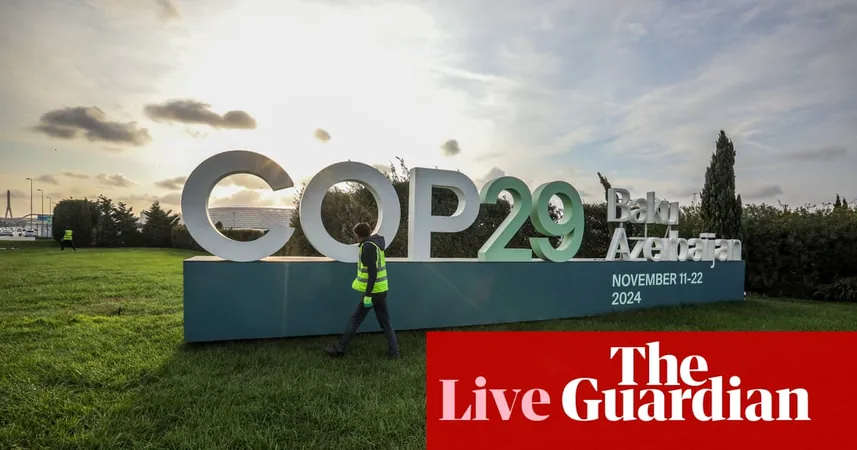
Are We Ignoring Climate Catastrophe? Emissions Still on the Rise Despite Global Summit!
2024-11-14
Author: Jia
As over 66,000 leaders, negotiators, and climate advocates gather at the COP29 summit in Baku, Azerbaijan during what is projected to be the hottest year on record, they are confronting a dire truth: global greenhouse gas emissions are continuing their upward trajectory, and the United States—one of the world’s largest carbon polluters—is considering withdrawing from climate agreements entirely.
Following Donald Trump’s recent victory in the 2024 presidential election, the U.S. risks reverting to a fossil fuel-heavy agenda, potentially reneging on its commitments under the Paris Agreement, just at the moment when the world needs decisive action. This is particularly alarming given the new report from Global Carbon Budget, which indicates that, despite expectations for a decline in global emissions, numbers are expected to increase by 0.8% compared to last year.
The implications of this trend are catastrophic for our climate goals. The aspiration to limit global warming to below 1.5 degrees Celsius now appears nearly unattainable. The ongoing summit, intended to strategize on climate action, is reportedly off to a rocky start with significant absences, including top negotiators from France and Argentina.
UN Secretary-General António Guterres highlighted the urgency, pointing out that we are witnessing record-breaking temperatures and mounting climate disasters affecting the most vulnerable populations. "Climate disasters are piling up—harming those who’ve done the least, the most," he declared, pressing the need for more robust efforts.
Despite the troubling rise in emissions, there is a silver lining: the growth rate of emissions is showing signs of deceleration. The surge in renewable energy sources such as wind and solar, coupled with the increasing market share of electric vehicles, suggests a potential turning point. However, the pace of change remains alarmingly slow.
What’s Driving This Increase in Emissions?
According to the latest findings, the primary driver behind the increase in emissions is the continued consumption of fossil fuels—particularly oil and gas. Although emissions from the European Union are on a downward trend, U.S. emissions remain flat, and China’s increase is minimal at only 0.2% this year.
In contrast, developing nations like India, which stands as the third-largest emitter globally, are ramping up fossil fuel usage alongside their burgeoning renewable energy sectors, resulting in a staggering projected 4.6% increase in emissions.
A combination of climate phenomena, particularly the remnants of El Niño, has contributed to soaring global temperatures, further escalating the demand for energy-intensive cooling solutions and driving fossil fuel consumption.
However, there’s hope. Several countries have demonstrated that economic growth can occur alongside reduced carbon emissions, breaking a long-standing trend. Not only are countries working to reduce their carbon footprints, but there are signs that many are nearing their peak emissions.
Turning the Tide: What Can Be Done?
The shift towards cleaner energy sources is crucial. By transitioning from coal reliance to cleaner natural gas, and expanding solar and wind usage, nations can begin to mitigate emissions. The electrification of transportation and improvements in energy efficiency are also essentials in this fight.
While government policy spurred initial advancements, economic factors are now leading the charge for cleaner energy solutions. As it turns out, renewables are often the most cost-effective option for electricity generation.
It’s critical to recognize that emissions are not solely driven by fossil fuel consumption; activities that destroy nature's carbon sinks, such as deforestation, also contribute significantly. Plus, greenhouse gases like methane are exacerbating the climate crisis.
Restoring ecosystem services through conservation strategies can help balance out emissions. There are hints that deforestation trends are beginning to reverse in some regions, promising a more sustainable future.
A Call to Action
While emissions are currently at a plateau, the potential for a downward trend hinges on our collective actions. Nations need to set ambitious climate targets, invest in renewable energy, and develop accountability measures.
The challenges are significant: global inflation, geopolitical disputes over energy resources, and the greater impacts of climate change on vulnerable nations must all be addressed. The immediate future of our planet hangs in the balance, yet the International community is at a pivotal moment to turn the tide in favor of sustainability and lower emissions.
Investment in clean energy technologies is crucial, particularly in developing countries that are facing the brunt of climate change effects. The UN estimates a staggering $1.3 trillion per year will be required by 2035 for these nations to adapt effectively.
Despite bleak projections regarding emissions, the case for action has never been clearer. Avoiding even the smallest increments of warming can mitigate devastating impacts and save countless lives. Our choices today will shape the climate reality of tomorrow—will we act to change course?





 Brasil (PT)
Brasil (PT)
 Canada (EN)
Canada (EN)
 Chile (ES)
Chile (ES)
 España (ES)
España (ES)
 France (FR)
France (FR)
 Hong Kong (EN)
Hong Kong (EN)
 Italia (IT)
Italia (IT)
 日本 (JA)
日本 (JA)
 Magyarország (HU)
Magyarország (HU)
 Norge (NO)
Norge (NO)
 Polska (PL)
Polska (PL)
 Schweiz (DE)
Schweiz (DE)
 Singapore (EN)
Singapore (EN)
 Sverige (SV)
Sverige (SV)
 Suomi (FI)
Suomi (FI)
 Türkiye (TR)
Türkiye (TR)